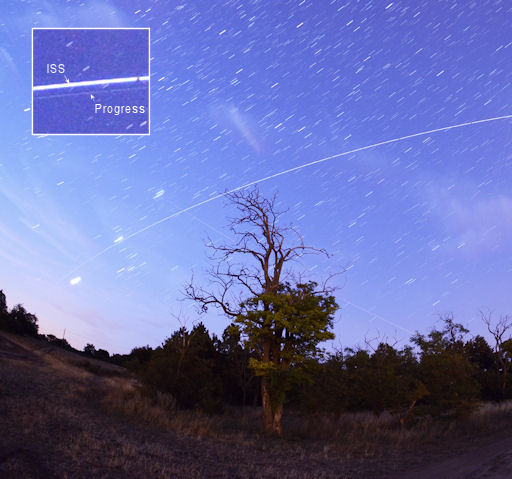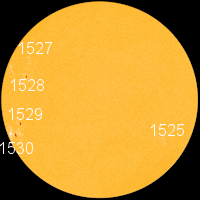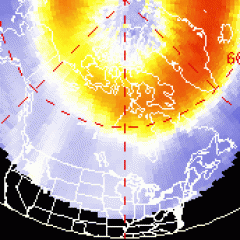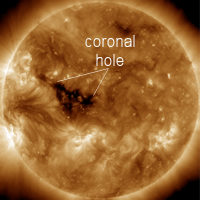LONG RANGE OUTLOOK: A stream of solar wind is heading for Earth, due to arrive on July 28-30. High-latitude sky watchers should be alert for auroras on those dates in case the impact sparks geomagnetic storms. Aurora alerts: text, voice.
MAGNETIC BRIDGE: Sunspots AR1528 and AR1529 appear to be far apart. More than 200,000 km of stellar surface separate the two. Nevertheless, they are connected by a tubular bridge of magnetism. NASA's Solar Dynamics Observatory (SDO) photographed the vast structure on July 24th:
This extreme ultraviolet image traces the bridge via the glow of hot plasma it contains. Material can flow back and forth inside the tube, allowing one sunspot to respond to what the other is doing.
Researchers once thought that sunspots were independent operators, but SDO has shown over and over again that widely-spaced sunspots can be linked. An eruption in one can set off an explosion in another, leading to a chain reaction that can spread around the circumference of the sun. The global eruption of August 2010 is a memorable example.
Realtime Space Weather Photo Gallery
BUSY INTERSECTION: The International Space Station is not alone. A Russian supply ship (the Progress M-15M) is chasing the ISS in its orbit around Earth. Monika Landy-Gyebnar saw them both when they passed over Veszprem, Hungary, on the morning of July 24th:
"As the ISS emerged from the shadow of Earth I noticed a faint small dot following the space station. It was the Progress M-15M," says Landy-Gyebnar. "The Progress was well visible until it reached the dawn-bright sky in the east. Also present were Jupiter, Venus, the Pleiades and the Hyades--stunning! I could not stop looking at them even after the ISS disappeared into the rosy dawn clouds by the horizon. A short timelapse shows the ISS+Progress pair flying less than a degree away from Jupiter."
Another spaceship will be arriving soon. Japan's "Kounotori 3" cargo carrier, also known as the HTV-3, is due to join the ISS around 7 am CDT on Friday, July 27th, carrying almost 4 tons of supplies and equipment. After the HTV-3 docks on Friday, the Progress rocket will follow suit on Sunday. Until then, there is plenty to see. Check the Simple Satellite Tracker or your smartphone for flyby times.

![]()
Solar wind
speed: 455.0 km/sec
density: 1.3 protons/cm3
explanation | more data
Updated: Today at 1357 UT
![]()
X-ray Solar Flares
6-hr max: B9 1040 UT Jul25
24-hr: B9 1040 UT Jul25
explanation | more data
Updated: Today at: 1400 UT
![]()
![]()
![]()
Daily Sun: 25 Jul 12
![]()
![]()
None of these sunspots poses a threat for strong flares. Credit: SDO/HMI
![]()
![]()
![]()
Sunspot number: 66
What is the sunspot number?
Updated 25 Jul 2012
Spotless Days
Current Stretch: 0 days
2012 total: 0 days (0%)
2011 total: 2 days (<1%)
2010 total: 51 days (14%)
2009 total: 260 days (71%)
Since 2004: 821 days
Typical Solar Min: 486 days
Updated 25 Jul 2012
The Radio Sun
10.7 cm flux: 102 sfu
explanation | more data
Updated 25 Jul 2012
![]()
![]()
![]()
Current Auroral Oval:
![]()
Switch to: Europe, USA, New Zealand, Antarctica
Credit: NOAA/POES
![]()
![]()
![]()
Planetary K-index
Now: Kp= 2 quiet
24-hr max: Kp= 3 quiet
explanation | more data
![]()
Interplanetary Mag. Field
Btotal: 3.6 nT
Bz: 0.6 nT north
explanation | more data
Updated: Today at 1356 UT
![]()
![]()
![]()
Coronal Holes: 25 Jul 12
![]()
![]()
A solar wind stream flowing from this coronal hole should reach Earth on July 28-30. Credit: SDO/AIA. ![]()






